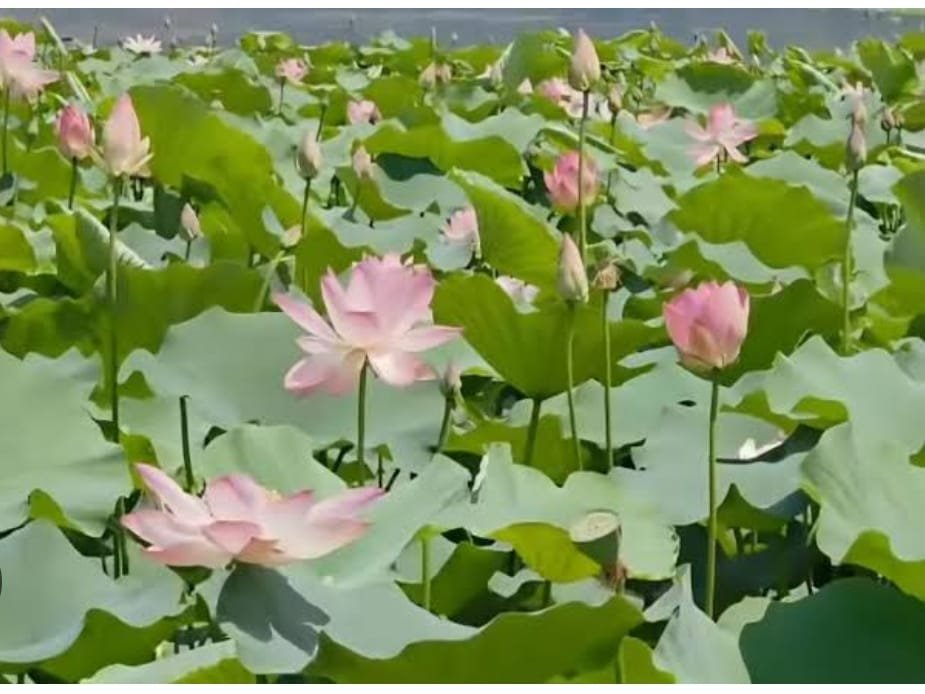Diplomat Correspondent
Srinagar, (DD)In a heartwarming development for Kashmir’s environmental and cultural landscape, lotus flowers have bloomed in Wular Lake — one of Asia’s largest freshwater lakes — for the first time in nearly 30 years. The rare and unexpected resurgence has brought immense joy and hope to the residents and farmers living around the lake in north Kashmir’s Bandipora district.
Large patches of Wular, particularly near the villages of Kulhama, Zurimanz, and Banyari, are now covered with blooming lotus flowers (Nelumbo nucifera), creating a surreal scene reminiscent of decades past. The bloom is being hailed as a symbol of ecological hope for a lake that has long suffered from neglect, pollution, siltation, and encroachments
For many older residents, the return of lotus flowers has sparked nostalgia. “I was a teenager when we last saw such a bloom in the early 1990s,” said Ghulam Rasool Dar, a 63-year-old farmer from Zurimanz. “The lake would be dotted with lotus leaves, and families like ours would harvest nadru (lotus stems) for food and income. It was a part of our life and livelihood.”
The nadru, a popular delicacy in Kashmiri cuisine, is also a significant source of livelihood for farmers during the summer months. The revival of lotus growth could thus rejuvenate the traditional economy of many rural households around the lake.
Mushtaq Ahmad, a 42-year-old harvester from Kulhama, expressed cautious optimism: “This bloom gives us hope. If it continues, our children might get to experience what we had — harvesting nadru in knee-deep water and earning a living from nature without harming it.”
Experts believe a combination of favorable ecological conditions may have led to the unexpected bloom. Better rainfall patterns over the last two years, partial clearing of silt and invasive weeds under ongoing restoration initiatives, and a drop in pollution in certain pockets could have created an environment conducive for lotus growth.
A senior official from the Wular Conservation and Management Authority (WUCMA), speaking on condition of anonymity, said: “It’s a positive sign and a surprise to many of us. We are monitoring the areas where lotus has reappeared. A detailed study will be initiated to determine whether this is a natural resurgence or an outcome of improved ecological practices.”
While the local community celebrates the return of the lotus, environmentalists have urged authorities and the public to treat this as a wake-up call for lake conservation. “Wular Lake is not just a waterbody; it’s a living ecosystem. The return of the lotus is a small, symbolic victory. We must build on this and accelerate lake restoration and protection efforts,” said Dr. Farooq Makhdoomi, an ecologist based in Srinagar.
Wular Lake has seen extensive degradation over the past few decades due to unregulated construction, encroachments, dumping of waste, and shrinking of its surface area. Conservation projects funded under the National Lake Conservation Plan (NLCP) have been underway for several years, but progress has been slow and sporadic.
Local residents are also hopeful that the lotus bloom could help attract tourists and nature enthusiasts. “Wular has always been beautiful, but now with lotus returning, more people might come to see this miracle,” said Shabir Lone, a houseboat owner near Banyari.
Social media has also played a role in amplifying the bloom’s significance. In the past few days, photos and videos of blooming lotus fields in Wular have gone viral, prompting interest from photographers, environmentalists, and tourists alike.
The return of lotus blooms to Wular Lake after three decades is more than just a visual delight. It is a sign of potential ecological healing, a revival of cultural heritage, and a glimmer of hope for hundreds of families who depend on the lake for sustenance. As the blooms sway gently in the summer breeze, they also carry a quiet message — that nature, when respected and nurtured, finds a way to return.(DD)





